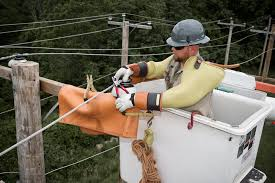Powering the Line: A Deep Dive into Modern Lineman Impact Wrenches and Crimpers

Howdy, y’all! Down here in Texas, we know a thing or two about hard work under a big sky. But few jobs are as demanding, or as crucial, as that of a power lineman. These folks are the unsung heroes keeping our lights on, whether it’s a scorching summer afternoon or the dead of a stormy night. And just like any master craftsman, a lineman is only as good as their tools. The days of relying solely on brute force are fading fast. Today, we’re talking about the game-changing innovations in lineman impact wrenches and crimpers – tools that are making the job safer, faster, and a whole lot easier on the body.
For an apprentice just starting out or a seasoned journeyman looking to upgrade their lineman tools kit, the technology packed into modern hand tools is nothing short of revolutionary. We’re not just tightening bolts anymore; we’re applying precision force with tools that are smarter and stronger than ever before. So, grab a cold glass of sweet tea, and let’s dive into the gear that’s defining the modern grid.
A Day in the Life: More Than Just Pliers and a Hard Hat
Before we get into the high-tech stuff, let’s paint a picture. A lineman’s daily carry is a testament to preparedness. It’s a carefully curated collection where every single item has a critical purpose. Of course, you’ve got the basics: Klein pliers, insulated screwdrivers, skinning knives, and adjustable wrenches. But the job goes way beyond what you can carry on your belt.
A fully stocked service truck is a mobile workshop. Inside, you’ll find everything from bolt cutters and cable hoists to the indispensable electrical hot stick. This crucial tool, sometimes called a shotgun stick, is a lineman’s lifeline, an insulated pole that allows them to safely manipulate energized lines from a distance. It’s a perfect metaphor for the job itself: a blend of hands-on skill and a deep respect for the raw power they’re controlling. But when it comes to bolting heavy hardware or making secure connections, two tools have seen the most dramatic evolution: the impact wrench and the crimper.
The Cordless Revolution: Lineman Impact Wrenches
Remember the days of lugging heavy, air-powered (pneumatic) impact wrenches up a pole, dragging a cumbersome hose behind you? Thank goodness those days are mostly gone. The advent of powerful, lithium-ion battery technology has completely transformed the impact wrench, making it one of the most valuable lineman tools in the arsenal.
What impacts does a lineman use?
Linemen aren’t just using any old impact wrench you’d find in a mechanic’s garage. They need tools built for the extreme conditions of their work. A lineman’s impact is typically a high-torque, cordless model, often with a 7/16-inch quick-change chuck designed specifically for the auger bits and sockets used on pole line hardware. These tools are built to be durable, weather-resistant, and balanced for use in awkward positions high off the ground.
What is the best impact wrench for a lineman?
Asking for the “best” impact wrench is like asking a Texan for the best BBQ joint – you’re gonna get a few different, passionate answers! However, the conversation almost always revolves around a few key players, most notably Milwaukee’s M18 FUEL series and DeWalt’s 20V MAX XR line.
- Milwaukee’s M18 FUEL 7/16″ Hex Utility High Torque Impact Wrench is often praised for its sheer power and features designed specifically for utility work, like its QUIK-LOK chuck. It’s a beast built for breaking loose old, rusted hardware.
- DeWalt’s 20V MAX XR models are renowned for their ergonomic design, reliability, and excellent battery platform. They offer a fantastic balance of power, weight, and comfort for all-day use.
Ultimately, the best choice comes down to personal preference, what battery platform you’re already invested in, and the specific demands of your job. The best advice? Get your hands on a few and see what feels right.
What is the maximum torque for an impact wrench?
Modern cordless impact wrenches are engineering marvels. It’s not uncommon to see top-tier models boasting well over 1,000 ft-lbs (foot-pounds) of fastening torque and even more “nut-busting” or breakaway torque, sometimes pushing 1,500 ft-lbs or higher. For a lineman, this immense power is critical for driving large lag bolts into utility poles or tightening the nuts on heavy cross-arm braces and transformers.
What are the different types of impact wrenches?
While linemen almost exclusively use cordless models today, it’s good to know the different types:
- Cordless (Battery-Powered): The undisputed king for field work. They offer incredible power with unmatched portability and freedom of movement.
- Corded (Electric): These offer consistent power without worrying about batteries but are impractical for climbing poles due to the cord.
- Pneumatic (Air-Powered): The old-school powerhouse. They are incredibly strong and durable but require a large air compressor and hose, making them unsuitable for line work.
Squeeze Play: The Power of Modern Crimpers
Just as crucial as securing hardware is making flawless electrical connections. For decades, this meant using long-handled manual crimpers. While effective, they required significant upper body strength, leading to fatigue and potential repetitive stress injuries over a long career. A study by the National Institute for Occupational Safety and Health (NIOSH) has highlighted the ergonomic risks associated with the forceful exertions common in line work.
Enter the battery-powered hydraulic crimper. These tools use an internal electric motor to drive a hydraulic pump, effortlessly producing the immense force needed to create a perfect, cold-weld connection on overhead connectors and lugs.
The benefits are huge:
- Reduced Fatigue: They turn a two-handed, full-body strain into a one-finger pull of a trigger.
- Increased Consistency: The tool applies the perfect amount of pressure every single time, eliminating guesswork and ensuring a reliable connection that will last for decades.
- Enhanced Safety: By making the process quicker and less physically demanding, linemen can focus more on their positioning and surroundings, especially when working in an elevated bucket or on a pole.
Climbing High: A Comparison of Pole Climber Materials
No discussion of lineman tools would be complete without talking about what gets them up the pole in the first place: their climbers, or “gaffs.” The material these are made from has a huge impact on a lineman’s comfort and daily experience.
- Steel: The traditional choice. Steel climbers are incredibly durable and cost-effective. They can take a beating and last for years. However, their major downside is weight. An extra pound or two on each leg adds up over a day of climbing, leading to greater fatigue.
- Aluminum: A more modern and increasingly popular option. Aluminum climbers are significantly lighter than their steel counterparts, which makes a world of difference in reducing leg strain and fatigue. They are a bit more expensive, but many veterans will tell you the comfort is well worth the investment.
- Titanium & Carbon Fiber: These are the ultra-lightweight, premium options. They offer the weight savings of aluminum (or even less) with strength comparable to steel. The trade-off? A much higher price tag. These are typically favored by linemen who spend a majority of their day on poles or those looking for the absolute best in comfort and performance.
For a new apprentice, durable and affordable steel climbers are a great starting point. As you advance in your career and spend more time climbing, upgrading to lighter aluminum or titanium gaffs can be a fantastic investment in your own long-term health and comfort.
read more : https://ecoyyn.com/
Conclusion: Investing in the Future
The tools of the trade are constantly evolving, and for the American lineman, these innovations are more than just conveniences. They are vital advancements in safety and career longevity. Modern lineman wrenches and battery-powered crimpers reduce physical strain, increase efficiency, and ensure the reliability of our electrical grid. From the electrical hot stick that provides a safe distance to the lightweight climbers that make the ascent easier, every piece of the lineman tools kit is designed to help these brave professionals do their job and get home safe. Investing in quality, innovative tools isn’t just an expense; it’s an investment in a safer and more sustainable career for the heroes who power our world.
Frequently Asked Questions (FAQs)
1. Can I use a standard 1/2″ drive impact wrench for line work? While you technically can for some tasks, it’s not ideal. Lineman-specific impact wrenches with a 7/16″ hex quick-change chuck are designed to work directly with the large auger bits and sockets used for pole hardware without needing an adapter, making them much more efficient and secure.
2. Are battery-powered crimpers really worth the high cost? Absolutely. The reduction in physical effort drastically lowers the risk of repetitive strain injuries to the shoulders, back, and arms. This makes it a long-term investment in your health and ability to continue working effectively throughout your career.
3. How often should I get my hot sticks tested? Every utility and employer has specific standards, but generally, hot sticks should be visually inspected before each use and undergo professional electrical testing on a regular basis, often annually or biannually, to ensure their insulating properties are not compromised.
4. What’s more important in an impact wrench: torque or impacts per minute (IPM)? For linemen, torque is king. You need the raw rotational force (torque) to drive large lag bolts and bust loose stubborn, corroded nuts. While IPM helps with speed, the sheer twisting power is the more critical specification for utility hardware.
5. Should I choose steel or aluminum climbers if I’m just starting my apprenticeship? Steel climbers are a fantastic, budget-friendly, and durable choice for an apprentice. They’ll allow you to learn the ropes without a huge initial investment. You can always upgrade to lighter aluminum or titanium climbers later in your career as you discover your personal preferences and physical needs.






